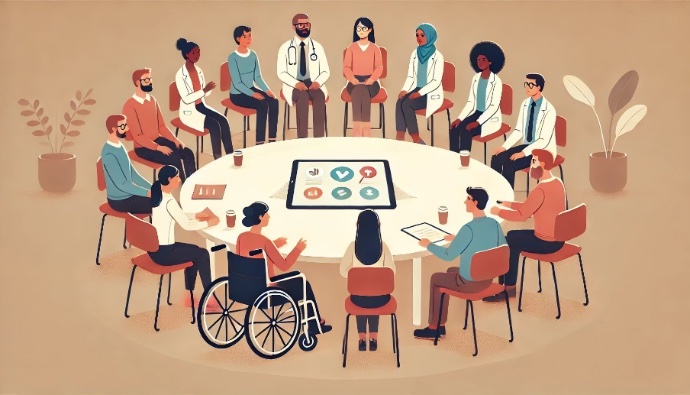By Julia Roper, Director of Strategy, Panorama Strategy

Artificial Intelligence (AI) is generating a lot of buzz across all sectors, and global health is no exception. Many see AI as a promising tool that could transform health systems, making them more effective and accessible. Like any breakthrough technology, however, AI comes with its own set of implementation challenges and unknowns. The good news? While we’re still in the early stages of understanding how to harness its potential, the global health field is not starting from scratch. We can learn from past innovations. By applying lessons from those efforts – what’s worked and what hasn’t – we can shape better, more practical strategies to ensure AI supports improved health and wellbeing worldwide.
Here are five lessons from other innovations that can guide the way we apply AI in global health:
-
Be wary of the parallel system
Wherever possible, innovations should strengthen existing systems rather than bypass them. New tools that rely on entirely separate delivery systems may show impressive results in controlled pilots but prove nearly impossible to scale (another tip for another time—be wary of pilot-itis!). For HIV care, integrating services into primary healthcare in countries across Africa has been shown to improve patient outcomes, increase retention, and strengthen broader health systems.[i] When working on AI-driven innovations, ask yourself how you can build on existing foundations, improving what’s already in place to ensure lasting impact.
-
Measure what matters
When working with clients on advocacy strategies, the first (or rather, the first four or five) conversations I have with them are focused on defining their audience—who they are, what they care about, and what will move them. In previous work on new vaccine introductions in Africa and Asia, I witnessed too many people pitch the wrong message to the wrong person—like making a case for long-term health benefits to a Minister of Finance focused on next year’s budget gap. The same principle applies beyond advocacy. Many promising medicines fail to reach key populations because clinical trials don’t reflect real-world conditions, leading to setbacks in effectiveness, safety, or regulatory approval. Those designing AI solutions should learn from this lesson: new tools should be built with real users and decision-makers in mind to ensure they fit the right context and deliver tangible value.
-
Know (and correct!) your bias
Time and again, bias has led to harm in healthcare. Pulse oximeters—widely used during the COVID-19 pandemic—were less accurate in detecting low oxygen levels in patients with darker skin tones, leading to delayed treatment.[ii] Drug trials historically left out women, leading to less effective or harmful treatments and side effects. AI is already showing similar risks, from facial recognition systems that misidentify or fail to recognize Black individuals altogether,[iii] to algorithms replicating and reinforcing biases in historical health data. The lesson here? Don’t treat bias as a hypothetical—treat it as inevitable. Bias will creep in, but the key is to recognize and correct it. Assume it exists, invest in diverse testing, engage equity experts, and build systems to actively identify and correct it. If we fail to address bias head-on, we could make the inequalities we are trying to fix even worse.

Don’t shy away from the less glamorous interventions
There’s no shortage of exciting innovations in global health—bandages that change color based on infection type, 3D printed prosthetics, smartphone microscopes, and more. But innovation is not always about the big breakthroughs. I’ll never forget the time I watched an analyst find a tiny Excel formatting error in a country’s ordering system—just in time to prevent an under-order of hundreds of thousands of essential medicines. That small fix prevented a supply shortage that could have led to hundreds of deaths. Some of the most impactful interventions aren’t flashy but practical: making sure health workers are paid on time, improving supply chain delivery route efficiency, strengthening community-based referral programs, enhancing diagnostic precision, or automating administrative burdens to ease burnout in the workforce. These areas might not make headlines, but they’re where AI could quietly transform health systems for the better. We don’t need everyone chasing uncharted territory – we need fresh solutions to everyday problems.
-
Don’t sit this one out
To my fellow social scientists: AI isn’t just for tech teams—it’s already influencing our field and has the potential to shape your work for the better. If you support community health programs, AI can help analyze data from frontline workers in real time. If you manage supply chains, it can flag stock shortages before they happen. If you write grant reports—now I have your attention—AI can help synthesize key takeaways and lighten the workload. Like any tool, AI’s impact depends on how it’s used and who’s shaping it. If global health stakeholders don’t engage, others will set the terms, often with little understanding of real-world needs. The best way to get started? Use AI to elevate what you’re already doing. And finally – as we’ve learned again and again from past interventions – local leadership, collaboration, and continuous learning will be essential ingredients for success.
What AI use cases in global health are you most excited about? What other lessons can we take away from past interventions?
Julia Roper leads the global health portfolio at Panorama Strategy, a consulting firm that partners with organizations and leaders to turn their vision for social impact into a reality. Our services include strategy development, stakeholder engagement, coalition building, philanthropic advising, strategic communications, issue advocacy, and convening and facilitation.
Get in touch at: Julia.roper@panoramastrategy.com
Citations
[i] PLOS Medicine, https://journals.plos.org/plosmedicine/article?id=10.1371/journal.pmed.1003836
[ii] JAMA Internal Medicine, https://pmc.ncbi.nlm.nih.gov/articles/PMC9257583/
[iii] MIT, https://news.mit.edu/2018/study-finds-gender-skin-type-bias-artificial-intelligence-systems-0212
Illustrations generated with creative help from ChatGPT’s Image Generator Tool by OpenAI